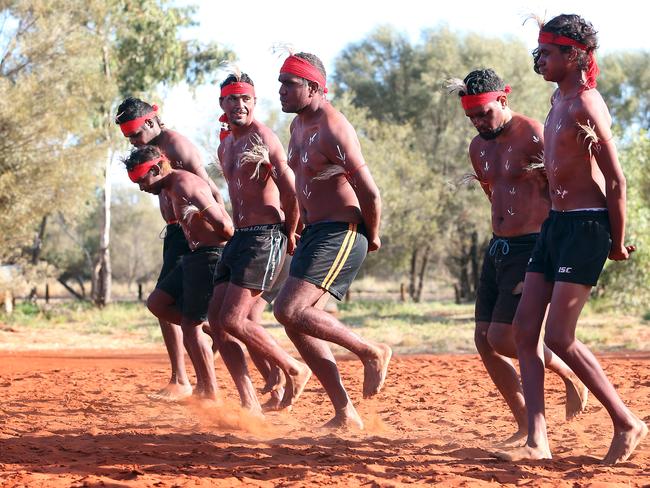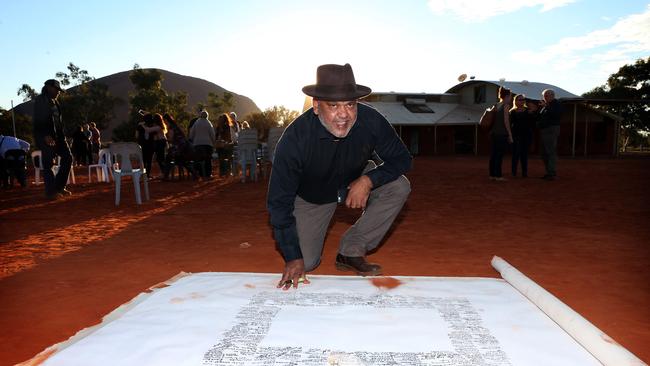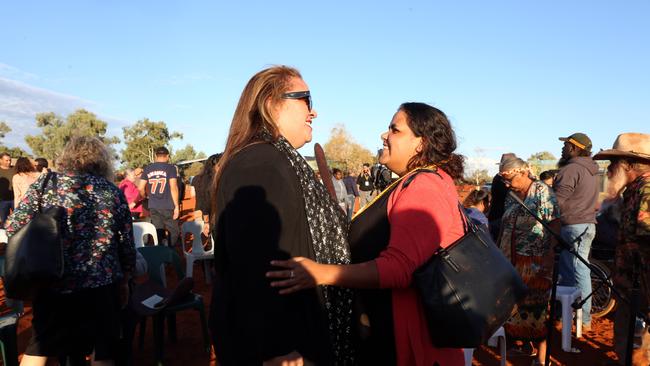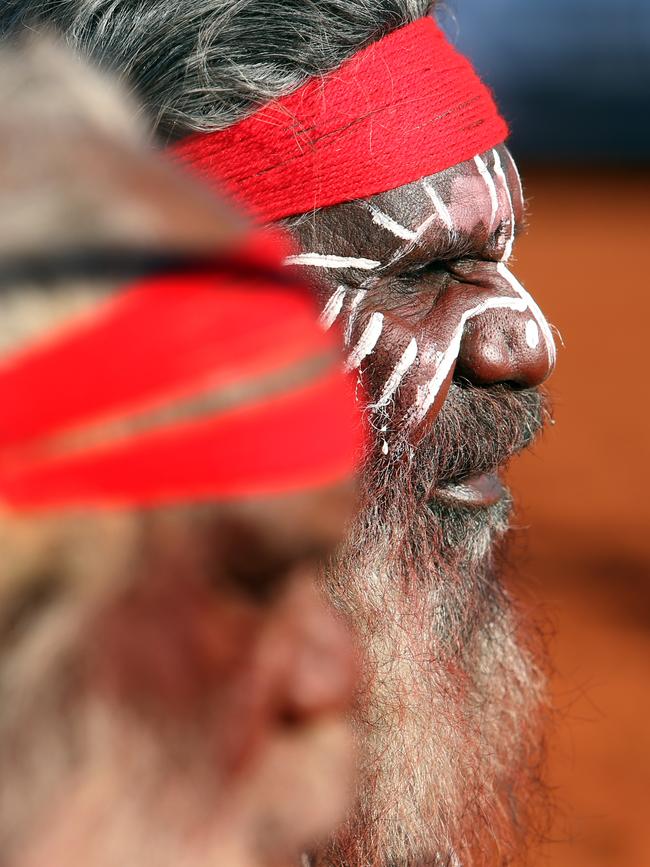Voice, treaty, truth: Why an indigenous agreement is vital for Australia
Without a treaty regulating non-indigenous peoples’ occupation, the legitimacy of the state of Australia is open to question.

Three years ago, on May 26, 2017, about 250 Aboriginal and Torres Strait Islander people “from all points of the southern sky’’ gathered on the red dust of Mutitjulu, in the shadow of Uluru, to call for meaningful reform to the Australian state. Their call for change came after 18 months of deliberation and dialogue at regional forums held across the country, and was expressed as the Uluru Statement from the Heart.
The statement is a powerful testament to Aboriginal and Torres Strait Islander peoples’ aspirations. Grounded in their inherent rights as the “first sovereign nations of the Australian continent”, it outlines three proposals to empower indigenous peoples so they can take “a rightful place in our own country”. Characterising the proposals as “Voice, Treaty, Truth”, the delegates called for a First Nations voice to be put in the Constitution with the power to advise the Australian parliament on laws that affect indigenous peoples, and a Makarrata Commission to oversee a process of treaty making and truth-telling.
Makarrata is a Yolngu word of the people from northeast Arnhem Land that means “a coming together after a struggle”. It has been used since the late 1970s to refer to a negotiated agreement between Aboriginal and Torres Strait Islander peoples and the Australian state that recognises each party’s authority and place in the nation. In the Uluru statement, the delegates left no doubt about their support for a treaty, explaining that: “Makarrata is the culmination of our agenda … It captures our aspirations for a fair and truthful relationship with the people of Australia and a better future for our children based on justice and self-determination.”
Since the delivery of the Uluru statement, discussion has focused on the first proposal: a national indigenous representative body. This is understandable. As a small minority, dispersed across the continent, Aboriginal and Torres Strait Islander peoples struggle to have their interests considered and their voices heard in the development and drafting of policy and legislation. A First Nations voice is seen as a remedy to that marginalisation. It speaks to a simple democratic proposition, the idea that Cobble Cobble professor of law Megan Davis identifies: “Indigenous peoples should have a say in the laws and policies that affect their lives and communities.”

Less attention has been paid to the second proposal: a Makarrata Commission. This reflects the Uluru statement calling for a sequence of reforms: First voice, then treaty, and finally truth. This is also understandable. Without a national representative body, there is a risk that the design and powers of a Makarrata Commission will not reflect the priorities or interests of Aboriginal and Torres Strait Islander peoples. Similarly, without a strong, national voice overseeing the process of treaty making, agreements may not meet indigenous peoples’ aspirations.
This has not stopped several states and territories from commencing Australia’s first treaty processes with the Aboriginal and Torres Strait Islander nations. Since 2016, Victoria, South Australia, the Northern Territory and Queensland have each officially committed to enter treaty negotiations. Reflecting the political nature of these agreements, the situation is complex and subject to change. In June 2018, for instance, a newly elected SA government abandoned the treaty process.
So far, treaty processes have only been established by Labor governments, but treaty making is not just the province of that party. On March 30, 2015, the Noongar people of southwest Western Australia voted to accept a settlement agreement negotiated with the Liberal WA government. The settlement is significant. It is the largest and most comprehensive agreement concerning Aboriginal interests in land in Australian history, involving about 30,000 Noongar people and covering about 200,000sq km from Jurien to Ravensthorpe. Its value is about $1.3bn and includes agreement on rights, obligations and opportunities relating to land, resources, governance, finance, and cultural heritage. In exchange for this package, the Noongar people agreed to surrender all current and future claims relating to historical and contemporary dispossession.
Although negotiated outside a treaty process, the settlement’s size and scope reveals it as Australia’s first treaty. This was recognised at the time by politicians in both major parties. Upon notification that the Noongar people had accepted the settlement, then premier Colin Barnett issued a press release noting that the “breakthrough agreement” was “a historic achievement in reconciliation” and an “extraordinary act of self-determination by Aboriginal people … provid(ing) them with a real opportunity for independence”. Deputy opposition leader Roger Cook agreed, saying the settlement “is in fact a classic treaty; it is a coming together between two nations to agree upon certain things, and in doing so, finding a way forward together and recognising each other’s sovereignty”.
Read more: Fears for indigenous treaty if LNP wins | New states of play on treaty | QLD's announces path to treaty | Door open to state voice, treaty, compo
The Noongar treaty has not yet taken effect, as several Noongar people have challenged it in court. Nonetheless, it is the first time a formal agreement that settles outstanding claims and recognises a right to self-government has been made with Aboriginal and Torres Strait Islander peoples.
What do we mean by a treaty?
The word treaty is a label used in different contexts. When it comes to agreements between the state and indigenous communities, it refers to a formal, legally binding instrument reached through respectful political negotiation in which both sides settle outstanding claims. This is consistent with the way many indigenous Australians also understand treaties.
For example, Palawa lawyer Michael Mansell has described a treaty as a “political settlement … where two litigating parties give ground to settle the dispute”. Likewise, Bundjalung conservative businessman and political leader Nyunggai Warren Mundine has argued that a treaty “marks the end of a conflict, draws a line in history and allows signatories to move on, based on a clean slate. A treaty requires and brings about mutual recognition and reconciliation.”

The parties to such an agreement can call it a treaty or they can call it something else, such as a compact, a settlement, a Makarrata or a document of reconciliation. The name given to an agreement is itself something that the parties can negotiate about. In the end, what really counts is the content of the agreement and the quality of the relationship it helps establish and consolidate.
Why do we need one for Australia?
There are a number of reasons why people think that governments in Australia should negotiate a treaty with Aboriginal and Torres Strait Islander peoples. For many people, a treaty is necessary to legitimate the existence of the Australian state. Aboriginal and Torres Strait Islander peoples never ceded sovereignty: the British simply took control without their consent. As the first indigenous person elected to the federal parliament, Jagera man and senator Neville Bonner explained:
“You did not ask my people if you could come here. You did not ask my people if you could occupy our land. You did not ask my people if you could stop us from living our traditional lives. You did not ask my people if we would wish to live under your laws, under your government and in your federation.”
Australia ignored the existence of hundreds of indigenous polities and the country was built on top of those nations. Without a treaty regulating non-indigenous peoples’ occupation, the legitimacy of the state of Australia is open to question.
Related to this point is another reason. Many people see a treaty as a belated act of nation building in which agreement about sharing the country can be reached between indigenous and non-indigenous Australians. In this sense, negotiating a treaty can go some way to fixing the original injustice that occurred when no treaty was struck at first contact. While a modern treaty cannot take us back to 1788 or the 1890s, it could today recognise the status and place of Aboriginal and Torres Strait Islander peoples both as sovereign peoples in their own right and as peoples within the nation.
Calls for a treaty are also motivated by the fact that Australian law provides limited recognition that indigenous people have interests in land and sea, as well as rights to self-determination reflecting their status as the original owners of Australia. Yawuru man and senator Patrick Dodson argues that a treaty could “acknowledge the dispossession that occurred and establish a settlement process to redress and resolve historical grievances. It could also provide a framework to recognise our unique rights and cultures as indigenous people and set out mutually agreed terms for our relationship with the Australian government.”
Another factor is the connected issue of socio-economic disadvantage. There has been a history of distinct treatment of indigenous people — dispossession, removal of children, destruction of culture and heritage, lack of access to education and health services. These systematic failures to recognise and protect indigenous people’s rights have driven the large disparity between indigenous living standards and those of the rest of Australia, an underlying cause of indigenous disadvantage.

Despite more than a decade of government effort to “Closing the Gap” between the lives of indigenous and non-indigenous Australians, statistics about indigenous people consistently show shorter life expectancy, higher infant-mortality rates, lower standards of literacy and education, higher unemployment and poorer housing. And while it is hard not to be concerned about the statistics, it is even harder not to be moved by the lives that many indigenous people lead in making up those numbers. It is instinctive to want to reach for solutions to alter these circumstances for indigenous people and their families, whether it be a house through the use of a land council’s assets, an Aboriginal teacher’s aide to work with kids in the classroom, or a job through an employment scheme.
Opportunities for
non-indigenous people
These are immediate responses that rely on the benevolence of government, but beyond these short-term solutions there is also a desire for longer-term improvements in the lives of indigenous people — guarantees of adequate health service, participation in the wealth generated on traditional lands, proper access to education and employment, recognition of rights to self-governance and customary law.
It is interest in this longer-term, structural alteration to the position of indigenous people that also motivates calls for a fundamental agreement between indigenous peoples and the Australian state. This shows how the debate about a treaty is part of a broader discussion about the place, rights and socio-economic conditions of Aboriginal and Torres Strait Islander people. For as long as the wide socio-economic disparity persists, there will be interest in the development of basic minimum standards, guaranteed under a legally binding agreement.
A treaty process also offers important opportunities for non-indigenous Australians. It allows them a way to come to grips with a challenging issue of great difficulty and complexity: how they relate to the indigenous peoples of the Australian continent. It can help bridge the gulf that has opened between indigenous people and the rest of Australia over more than 230 years. It can offer better mutual understanding, better public policy in indigenous affairs, better results from the expenditure of money in areas such as health, housing and education. It can help in building a better nation, more secure in its identity, its symbols and its values. As the Uluru Statement from the Heart records, through a treaty Aboriginal and Torres Strait Islander peoples’ “ancient sovereignty can shine through as a fuller expression of Australia’s nationhood”.
George Williams is dean and Harry Hobbs a lecturer in the faculty of law at the University of NSW. This is an edited extract from their book Treaty, available now from Federation Press.

To join the conversation, please log in. Don't have an account? Register
Join the conversation, you are commenting as Logout